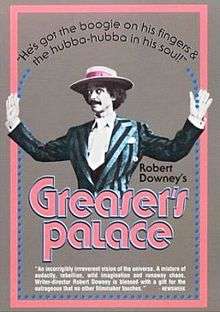Greaser's Palace
| Greaser's Palace | |
|---|---|
 DVD cover | |
| Directed by | Robert Downey Sr. |
| Produced by | Cyma Rubin |
| Written by | Robert Downey Sr. |
| Starring | Allan Arbus |
| Music by | Jack Nitzsche |
| Cinematography | Peter Powell |
| Edited by | Bud S. Smith |
| Distributed by | Cinema 5 Distributing |
Release dates | July 31. 1972 (US) |
Running time | 91 minutes |
| Country | United States |
| Language | English |
Greaser's Palace is a 1972 American acid western cult film[1][2] directed by underground filmmaker Robert Downey Sr. A parable based on the life of Christ, it utilizes surrealist comedy in a setting of America's frontier days.
Plot
Greaser's Palace follows Jesse (Allan Arbus), a Christ-like figure in a zoot-suit, on his way to Jerusalem to find work as a singer-dancer-actor. In a run-down Western town, he runs afoul of the local boss, Seaweedhead Greaser (Albert Henderson), until he brings Greaser's son Lamy (Michael Sullivan) back from the dead.
Cast
|
|
Cast notes:
- Robert Downey, Jr., the son of the writer-director of the film, has an uncredited role as a Quasimodo-like child. Elsie Downey who played "the Woman" was Robert Downey Sr.'s wife. Also in the cast were Allyson Downey and Stacy Sheehan, Downey Sr.'s daughter and niece.[3]
Production
Greaser's Palace, which was shot on location in New Mexico, was produced by Cyma Rubin, a neophyte Broadway producer who gave Downey a million dollars to make the film.[3] Downey had previously made the cult hit Putney Swope (1969) as well as lesser-known films such as Pound (1970), Babo 73 (1964) and Chafed Elbows (1966).[4]
Reception
Although Time magazine's Jay Cocks called it "Downey's funniest, most accomplished and most audacious film yet" and "the most adventurous American movie so far this year",[4] Greaser's Palace did not receive generally good critical reviews. Thomas Meehan, writing in the Saturday Review said "Robert Downey seems to have absolutely everything it takes to be a successful movie director except talent," and thought that this film was "even worse than his earlier pictures – an absurdist, incomprehensible Western that mixes in scatology, William Morris agents and the second coming of Christ." Kevin Thomas, the critic for the Los Angeles Times wrote of it "...the film is so utterly devoid of wit and imagination that the unremitting gross behavior and language it wallows in is quickly revolting." Kathleen Carroll, critic for the New York Daily News asked "Does this weird concoction of Harvard Lampoon parody, half-serious symbolism and silly slapstick really work?"
The film, which was presented at the Telluride Film Festival in 1976,[5] was not a commercial success.[4]
See also
References
Notes
- ↑ Sherman, Dale. Quentin Tarantino FAQ: Everything Left to Know About the Original Reservoir Dog Hal Leonard Corp., 2015. ISBN 9781495025969
- ↑ Verrier, Richard. "Great Read: A painstaking effort to reunite forgotten films with their owners" Los Angeles Times (February 5, 2015)
- 1 2 TCM "Notes"
- 1 2 3 Stafford, Jeff "Greaser's Palace" (TCM article)
- ↑ Allmovie "Awards"
External links
- Greaser's Palace at the Internet Movie Database
- Greaser's Palace at the TCM Movie Database
- Greaser's Palace at AllMovie